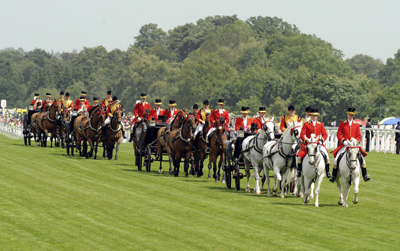The Queen's Coronation: All The Queen's Horses by Lionel Edwards
From the Country Life Archive: Lionel Edwards meets the horses of the Royal Mews. Originally published in the Country Life Coronation Number, June 1953.


RETURN TO THE CORONATION HOMEPAGE
The Royal Mews was originally in Trafalgar Square, approximately on the site of the National Gallery. Now it is behind Buckingham Palace. In these mechanised days the Mews is shorn of much of its panoply and for reasons of economy the number of horses is only about 35, although there is still accommodation for 90. These horses are all harness animals, which are difficult to find today, as the shrinkage of the horse population as a whole makes the market restricted. Big horses are necessary for big carriages and, of course, good looks are essential for pageantry.
The Greys (miscalled Windsor Greys) are eleven in number and are bought mostly in Ireland, but Queen Wilhelmina, shortly after the war, graciously presented six greys to the Royal Mews and a number of blacks to the Household Cavalry. Eight of these greys, ridden by postilions, draw the State Coach. When it is remembered that the State Coach is 13ft. high, 24ft. long and 8ft. wide, and weighs four tons when empty, it is not surprising that it requires eight horses to draw it.
The veteran of the greys is Noah, who was bought from Thomas Tilling (the bus proprietors) in 1937. He was then a six-year-old. By the staff Noah is called Chirgwin, owing to his peculiar markings suggesting the make-up of the one-time comedian known as the White-eyed Kaffir. The majority of these grey horses are named after famous Service Chiefs: Tedder and McCreery are lead horses, and one of the wheelers is named Eisenhower. Perhaps the greatest character among, and certainly one of the best looking of, the greys is Wavell, who is a ride horse. He usually appears as such in the procession at the Royal Ascot meeting, and one recalls that he led the parade at the Horse of the Year Show at Harringay last year. On the last evening the procession was led by Pompey, the drum horse of the Life Guards, and Wavell distinctly showed his annoyance at being superseded.

The Royal procession at Ascot, 2009.
Click the image above to purchase from the Country Life Picture Library
In the Royal Stables the greys are in stalls on one side and the bays on the other. The stable fittings are Victorian and much the same as those of any other stables of that period, except that they are better kept.
Exquisite houses, the beauty of Nature, and how to get the most from your life, straight to your inbox.
When examining the ordinary State carriages, which are painted red and gold and chocolate with red and gold hammer-cloths, I was struck by the height from the ground of the only step on to the coachman's box, it seemed to me that it would require an acrobatic feat to reach it. In fact, the coachman mounts from a step-ladder, and stays on his lofty perch until the carriage returns to the stables. These carriages are used on various occasions, such as when a foreign ambassador presents his credentials to the Queen. The coachman wears a many-caped scarlet cloak, a top hat with a gold band and cockade. His nether garments are hidden by the length of his cloak.
The carriages are drawn by Cleveland bays, which, like the greys, are difficult to obtain, as there are only two or three studs left in the country. The demand for hunters has to some extent altered the type and size of these animals, which were originally big horses with long backs, so that they could be used for riding pillion. The improvement of roads and the use of wheeled vehicles saw the end of that variety of equestrianism, but these big horses remained in demand for coach and carriage until late-Victorian times. In my young days a matched pair of these handsome horses cost 250 to 300 guineas, and I dread to think what one would have to pay today - if one could find them.
There are at the moment 19 bay horses in the Royal Mews, but only a few of these pairs are pure-bred Clevelands; one pair, 17 hands high, are truly magnificent specimens. Only geldings are used in the Royal Stables, which also makes it more difficult to obtain Clevelands, as there is such a demand for this breed abroad that it does not pay to have colts gelded. Mares are too temperamental for State carriages, being apt, like others of their sex, at times to kick over the traces.
The coachmen in the Royal Mews have in most cases started as postilions, who are recruited from the R.H.A. - a source restricted to the King's Troop in these mechanised days. They are taught both to ride and to drive in the Mews, as few have had previous experience of driving. The footmen who stand behind on the State carriages used to have a certain amount of stable training, but today they are drawn from the Palace staff.
Stable routine in the Royal Mews is much the same as anywhere else. Most horses are ridden first exercise in the riding-school and second exercise in the parks and streets. The servants wear the familiar drab overcoats and top hats on these occasions, as they do for all routine duties, such as collecting baggage and so forth. The pairs are driven for exercise in brakes, and much stress is laid on teaching horses to sit back in the breeching down-hill, as the State carriages have no brakes. Fortunately a London driver has few hills to negotiate, but he has slippery roads instead. Shoes with studs all round prevent this danger from being serious.
In the past in State processions only the Sovereign was drawn by white horses, but in these days of a sadly reduced horse population the colour question has to be ignored.
RETURN TO THE CORONATION HOMEPAGE
READ: THE CROWNING DAY BY IVOR BROWN
READ: IN THE ABBEY BY JOHN BETJEMAN
READ: THE CORONATION CHURCH BY LAWRENCE E. TANNER
READ: A PORTRAIT OF QUEEN ELIZABETH II
Agnes has worked for Country Life in various guises — across print, digital and specialist editorial projects — before finally finding her spiritual home on the Features Desk. A graduate of Central St. Martins College of Art & Design she has worked on luxury titles including GQ and Wallpaper* and has written for Condé Nast Contract Publishing, Horse & Hound, Esquire and The Independent on Sunday. She is currently writing a book about dogs, due to be published by Rizzoli New York in September 2025.
